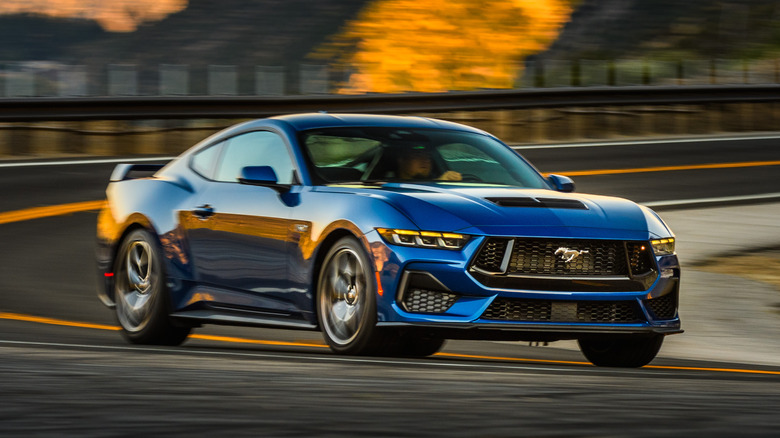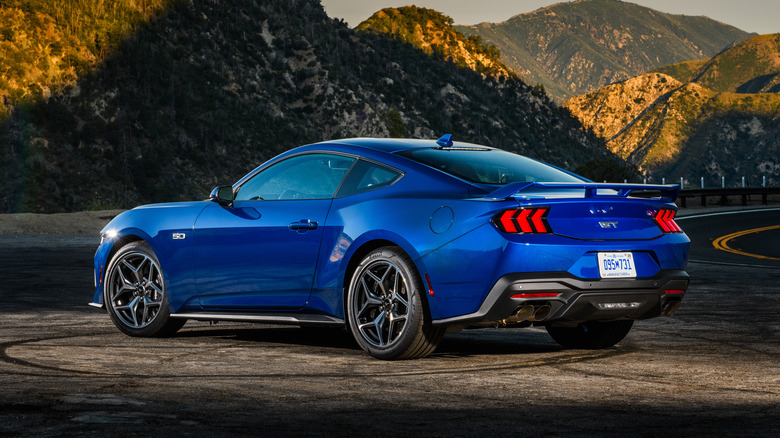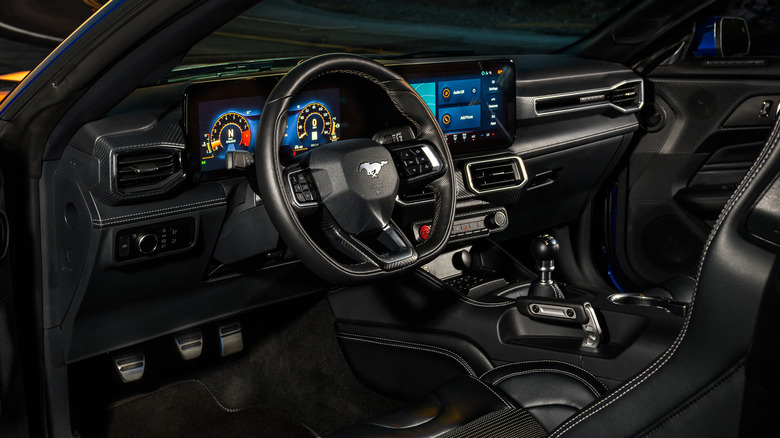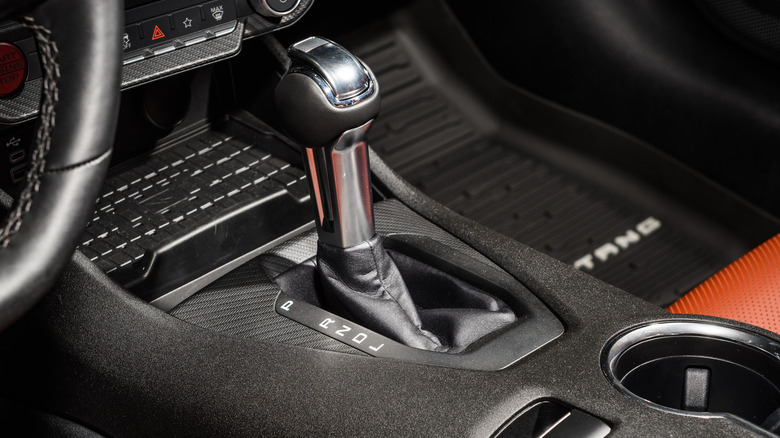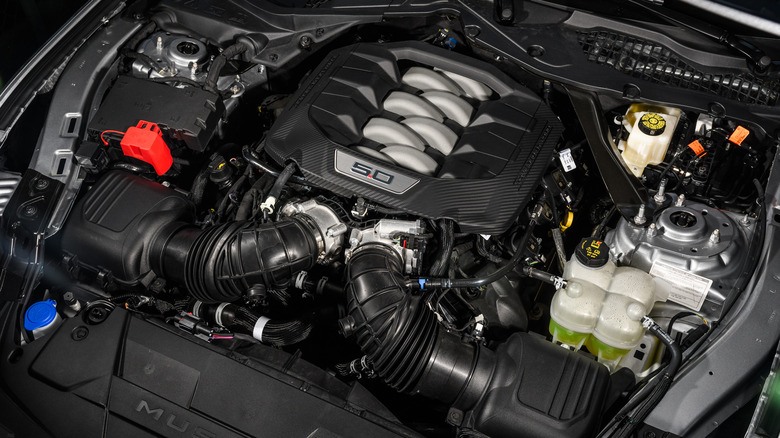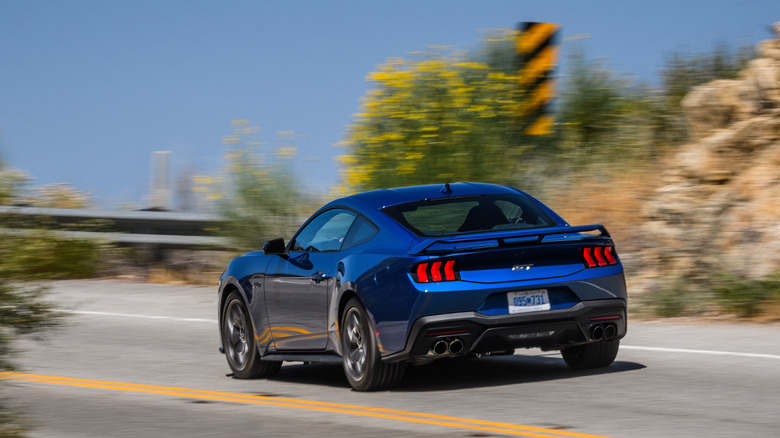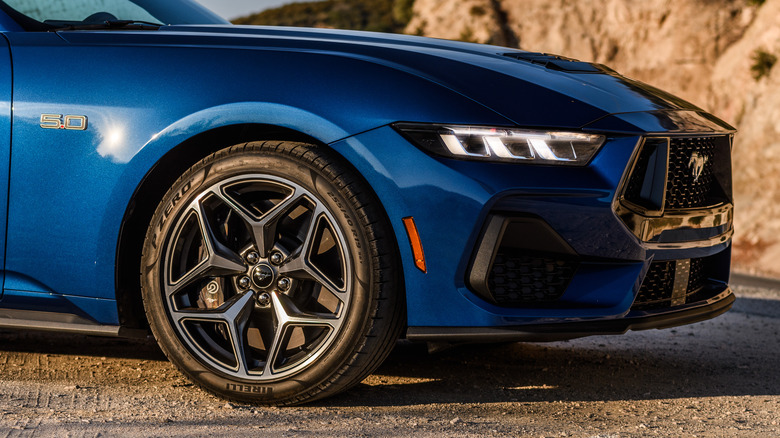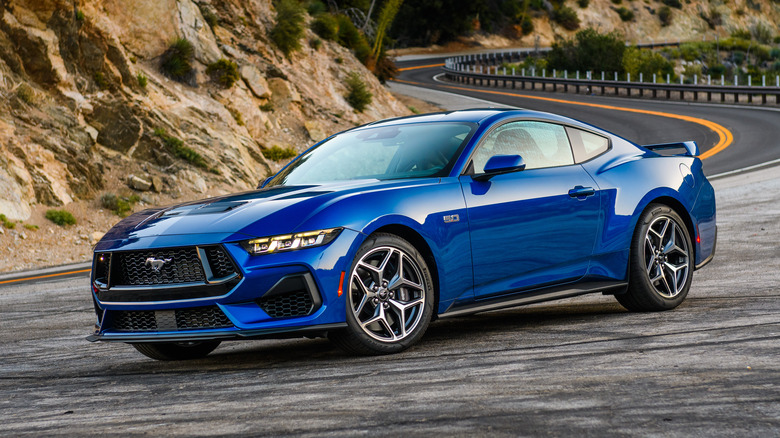2024 Ford Mustang GT First Drive: Bigger Burnouts, Better Balance
Evolution's been kind to the Ford Mustang. With each new generation, Ford's icon manages to sharpen its sports car chops without forgetting its muscle car roots — or its rental fleet star status. This "better for everyone" improvement strategy allows the Mustang to appeal to new clientele while still satiating the needs of big burnout bros. Perhaps that's why, with the Chevrolet Camaro and Dodge Challenger not long for this world, the Mustang will soon be the last pony car standing.
Ford smartly chose to not completely upend the Mustang's core formula, instead making this seventh-generation car more or less a reskinned and tech-enhanced version of its predecessor. Both the coupe and convertible body styles remain, as do the turbocharged inline-four and free-breathing V8 engines. There's a track-focused Mustang Dark Horse in the lineup, too, but that's another story for another day.
About that new look...
While I realize styling is subjective, I've polled a few friends and colleagues and the opinions are unanimous: The Mustang looks worse than before. Maybe it's the busy front fascia, the compacted taillights or the GT's AutoZone-discount-rack rear wing. Whatever the case, the Mustang isn't the same looker it once was. Someone even asked me if it was a Camaro. Ouch.
There are lots of new exterior colors, and wheel sizes range from 17 inches on the base car to optional 20s on the GT. You can add visual flair with options like the blacked-out Nite Pony Package or Bronze Appearance Package, the latter of which adds some extremely good wheels.
Loads of new cabin tech
The Mustang's interior gets the brunt of the big interior changes, with an almost overwhelming amount of digital real estate immediately noticeable when you open the door. Yes, that's a 12.4-inch digital gauge cluster and 13.2-inch central multimedia screen, all housed in one curved display that really dominates the dash.
The good news here is that the Mustang's optional mega-tech display works well. Powered by the Unreal Engine gaming processor, the gauge cluster's graphics are high-res and snappy, with visual skins tied to the various drive modes, as well as a retro '80s Fox Body Mustang look. The Sync 4 software housed in the infotainment display is simple to use, and the icons are large enough that you can easily operate the system at a quick glance while driving. Don't want to use Ford's native interface? Apple CarPlay and Android Auto connect wirelessly.
However, the bad news is that, overall, the Mustang's interior is pretty drab. Some of the black leather surfaces feel nice, but other plastics are hollow and hard to the touch. You also sit pretty low behind the steering wheel, with outward visibility made worse by the tall screens. At least the seats are comfortable, and have optional heating and cooling. The back seats aren't total penalty boxes, either, though headroom is in short supply. Well, unless you get the convertible.
The turbo is tempting, but there's a big omission
The Mustang's base engine is the same 2.3-liter turbocharged inline-4 as before, now making 315 horsepower at 5,500 rpm and – more importantly – 350 pound-feet of torque at 3,000 rpm. For most buyers and 100 percent of Los Angeles tourists at the Hertz desk, this EcoBoost powertrain will be just fine, with enough oomph to keep the Mustang entertaining without unnecessarily blowing your doors or hairpiece off. Going for the turbo gives the Mustang an efficiency bonus, too; the EPA says you can expect 22 mpg city, 33 mpg highway and 26 mpg combined. Not bad, all things considered.
One big downgrade for the 2024 Mustang: The turbo engine can only be paired with Ford's 10-speed automatic transmission. Sure, this is a smart and sophisticated gearbox, but I always loved the combination of turbo torque and a manual transmission in the last-gen Mustang. I'm hopeful that Ford will bring this option back, maybe in some kind of special edition package. But who knows. It probably won't happen.
The V8 is just so good
Thankfully, the Mustang GT still comes with a six-speed manual, and it's a good one, with a well-weighted clutch pedal, clear take-up point and great technologies like no-lift upshifting and automatic rev-matching downshifts. You can complain about those tech features watering down the experience of driving a manual, but on the contrary, they make it much easier to operate a stick-shift in everyday driving and improve performance.
And you know, a manual transmission paired with a naturally aspirated 5.0-liter V8 really is something special. I love Ford's Coyote V8 engine; the linear application of power and lovely sound totally seal the deal. Sure, it's inefficient — I'm talking 14 mpg city and 23 mpg highway with the manual — but that's not why you're buying a V8 in the first place. You want it for its 480 hp at 7,150 rpm and 415 lb-ft of torque at 4,900 rpm. Or, if you spec your GT with the active exhaust, 486 hp and 418 lb-ft. A tiny bonus for selecting the loud option.
Better to drive, easier to drift
Whipping around Southern California, I can really feel the Mustang's improved agility. A limited-slip differential keeps power moving across the rear axle to help with grip and balance, and the 2024 Mustang's quicker steering ratio makes this car more eager to turn in, with better feedback through the wheel. There's enough midrange power from the V8 engine that you can slink between tight turns in third or fourth gear without having to downshift, but then again, it's hard to resist the temptation to redline this thing all of the time, just to hear those eight cylinders on max attack.
If you're more of the, let's say, traditional Mustang mindset, you'll appreciate that Ford still equips the Mustang with line lock, which automatically holds the front brakes so you can easily impress your friends and annoy your neighbors by firing off huge smoky burnouts. There's also an optional electronic parking brake that works well for drifting, letting you pull it for better control over the rear wheels while sliding. Careful around crowds, natch.
Speaking of careful, the 2024 Mustang has a few driver-assistance technologies of note, including adaptive cruise control, blind-spot monitoring, lane-centering assist, pre-collision braking and more. Most of this stuff even comes standard. Awesome.
Mustang pricing at a glance
Ford raised the Mustang's price slightly for this new generation, so you can't get into one for less than $32,515, including a $1,595 destination charge. If you demand sunshine and the wind in your hair, you'll have to pay for the privilege: The Mustang convertible is an $8,100 upcharge, which, yeesh.
Options and pricing get a little more complicated from there. The cheapest way to get a V8 engine is the $44,090 Mustang GT Fastback, but if you're keen to add the performance pack — which gets you a better wheel/tire setup, larger Brembo brakes, a Torsen differential and more — you have to start with the $48,610 Mustang GT Premium Fastback. Want a V8 convertible? That's only available with the Premium trim, meaning you'll need a minimum of $54,110.
Track rats and gotta-have-the-best buyers might skip the GT altogether and spring for the $60,865 Dark Horse, which turns the wick on the V8 engine up to 500 hp and 418 lb-ft of torque, and comes with some standard go-fast upgrades. Without having driven it (yet), it's hard to say whether or not the Dark Horse will prove to be a worthy upcharge over a Mustang GT with the performance pack, but stay tuned.
The same 'Stang, just better
As the Mustang evolves, so too do its competitors. The traditional Camaro and Challenger comparisons can still be made, but not for much longer. And given the Mustang's increased focus on sharp handling, this opens the door for a longer list of rivals. The BMW M2, Nissan Z and Toyota Supra are all formidable foes.
Nevertheless, the continued march of progress is only making the Mustang better. Whether you value balance or burnouts, Ford's pony car has you covered.
